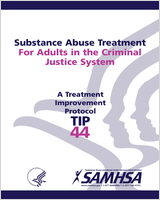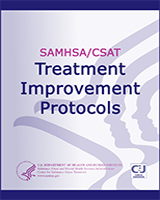This TIP Planning for Alcohol and Other Drug Abuse Treatment for Adults in the Criminal Justice System presents guidelines to help bring the criminal justice and AOD systems closer together, to more systematically promote the acceptance of AOD treatment for criminal offenders, and to enhance the effectiveness of that treatment. The current state of AOD treatment in the criminal justice system is reviewed, and selected characteristics of AOD-involved offenders are described. An overview of the criminal justice continuum, from arrest and pretrial through jail and prison, is presented. Goals and components of AOD abuse treatment are described, and a systems approach to planning and implementing AOD treatment in the criminal justice system is outlined. Issues such as training staff, protecting client confidentiality, and evaluating processes and outcomes are addressed in individual chapters.
Contents
- What Is a TIP?
- Consensus Panel
- Foreword
- Chapter 1—Introduction
- Chapter 2—The Effectiveness of AOD Treatment in the Criminal Justice System
- Chapter 3—The AOD-Involved Offender
- Chapter 4—The Criminal Justice Continuum
-
Chapter 5—The AOD Abuse Treatment System
- The Role of State AOD Agencies
- CSAT's Two-Phased Technical Assistance Program
- Overcoming Barriers
- Fragmentation of Services Within the AOD Treatment System
- Federal Block Grants and Other Funding Sources
- Treatment System Goals
- Prevention of AOD Abuse
- Criminal Justice System Treatment
- Treatment Components
- Case Management
- Treatment Types and Modalities
- Criminal Justice Sanctions And Treatment Incentives
- Conclusions: The Importance Of Linkages and Joint Decisionmaking
- Endnote
- Chapter 6—Collaboration Between Systems
- Chapter 7—Coordinated Training
- Chapter 8—Confidentiality Issues 5
- Chapter 9—Evaluation
- Appendix A -- Bibliography
- Appendix B—CSAT Criminal Justice Treatment Planning Chart
- Appendix C—Sample Interagency Agreement
- Appendix D—Federal Resource Panel
- Appendix E—Field Reviewers
This publication is part of the Substance Abuse Prevention and Treatment Block Grant technical assistance program. This publication was written under contract number ADM 270-91-0007 from the Center for Substance Abuse Treatment of the Substance Abuse and Mental Health Services Administration (SAMHSA). Sandra Clunies, MS, served as the CSAT Government project officer, and Roberta Messalle was the Government content advisor. Text development was provided by Carl Leukefeld, DSW Writers were Carolyn Davis, Joni Eisenberg, Constance Gartner, Randi Henderson, and Deborah Shuman.
The opinions expressed herein are the views of the consensus panel members and do not reflect the official position of CSAT or any other part of the U.S. Department of Health and Human Services (DHHS). No official support or endorsement of CSAT or DHHS for these opinions or for particular instruments or software that may be described in this document is intended or should be inferred. The guidelines proffered in this document should not be considered as substitutes for individualized patient care and treatment decisions.

